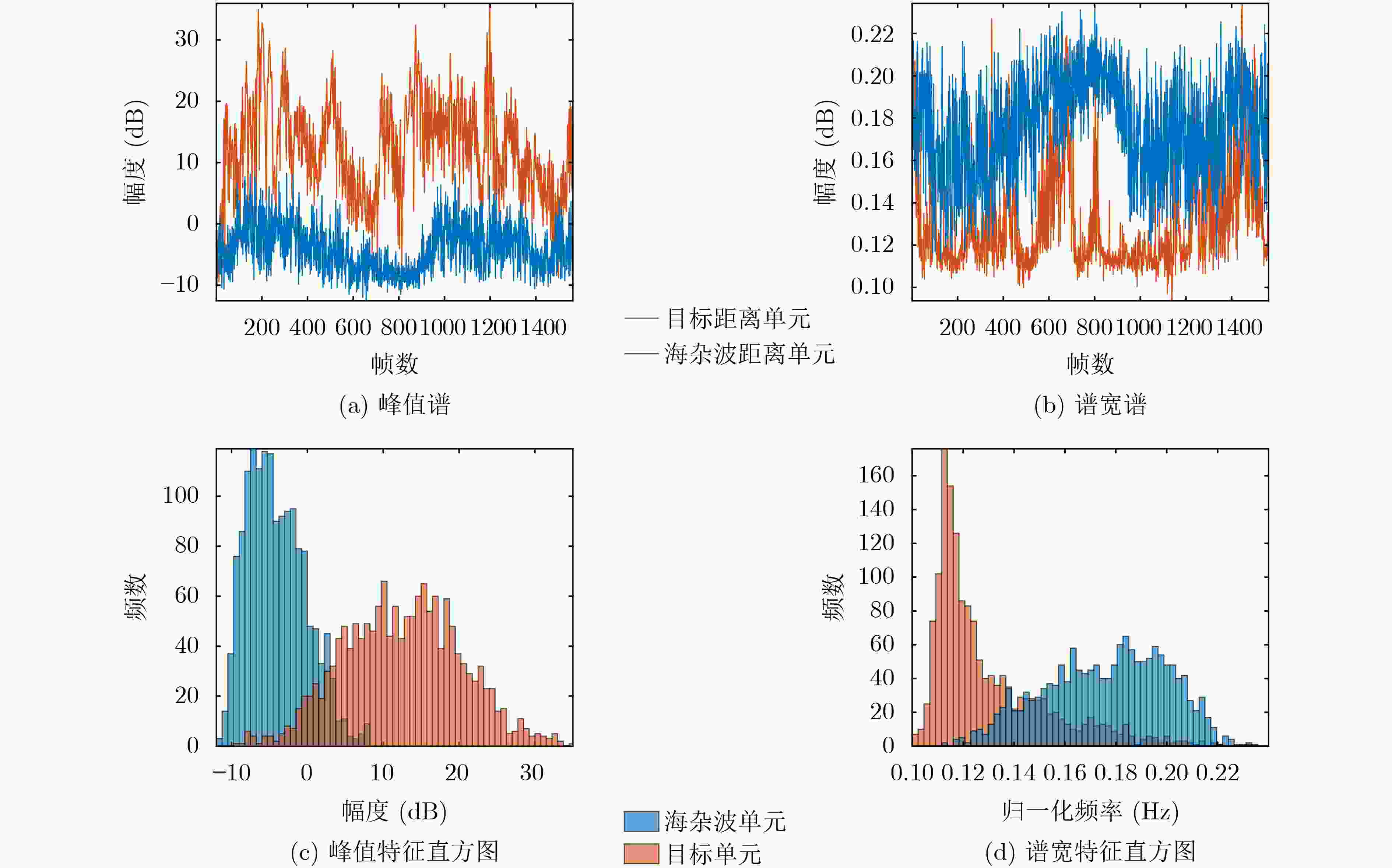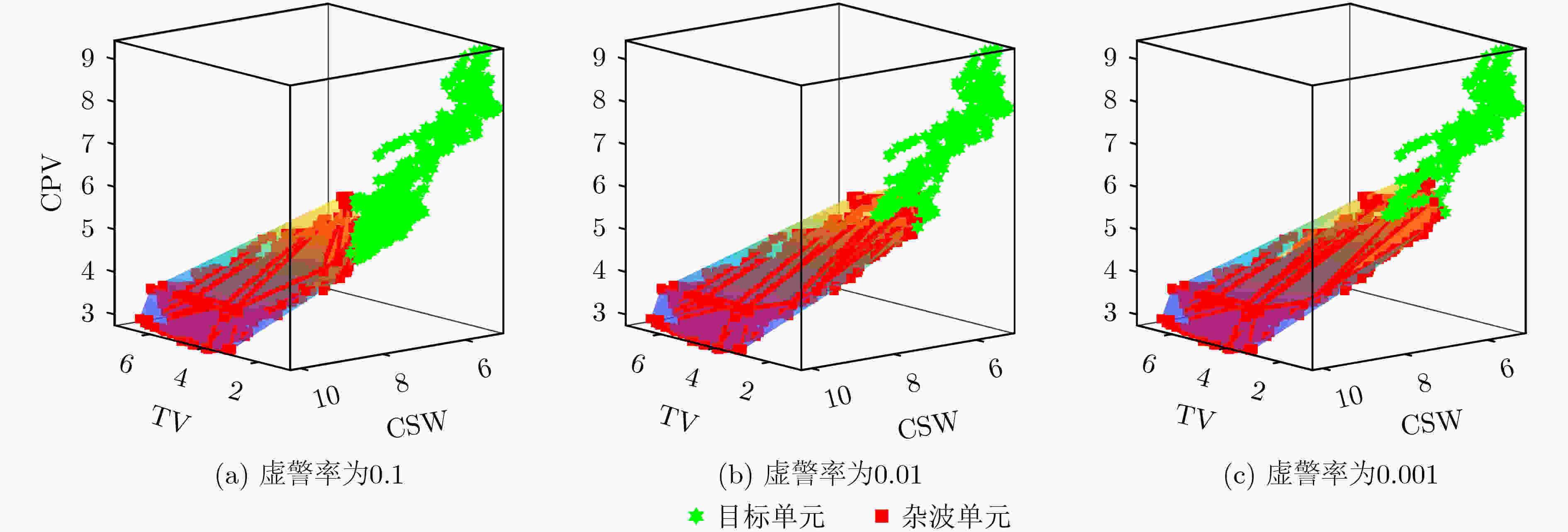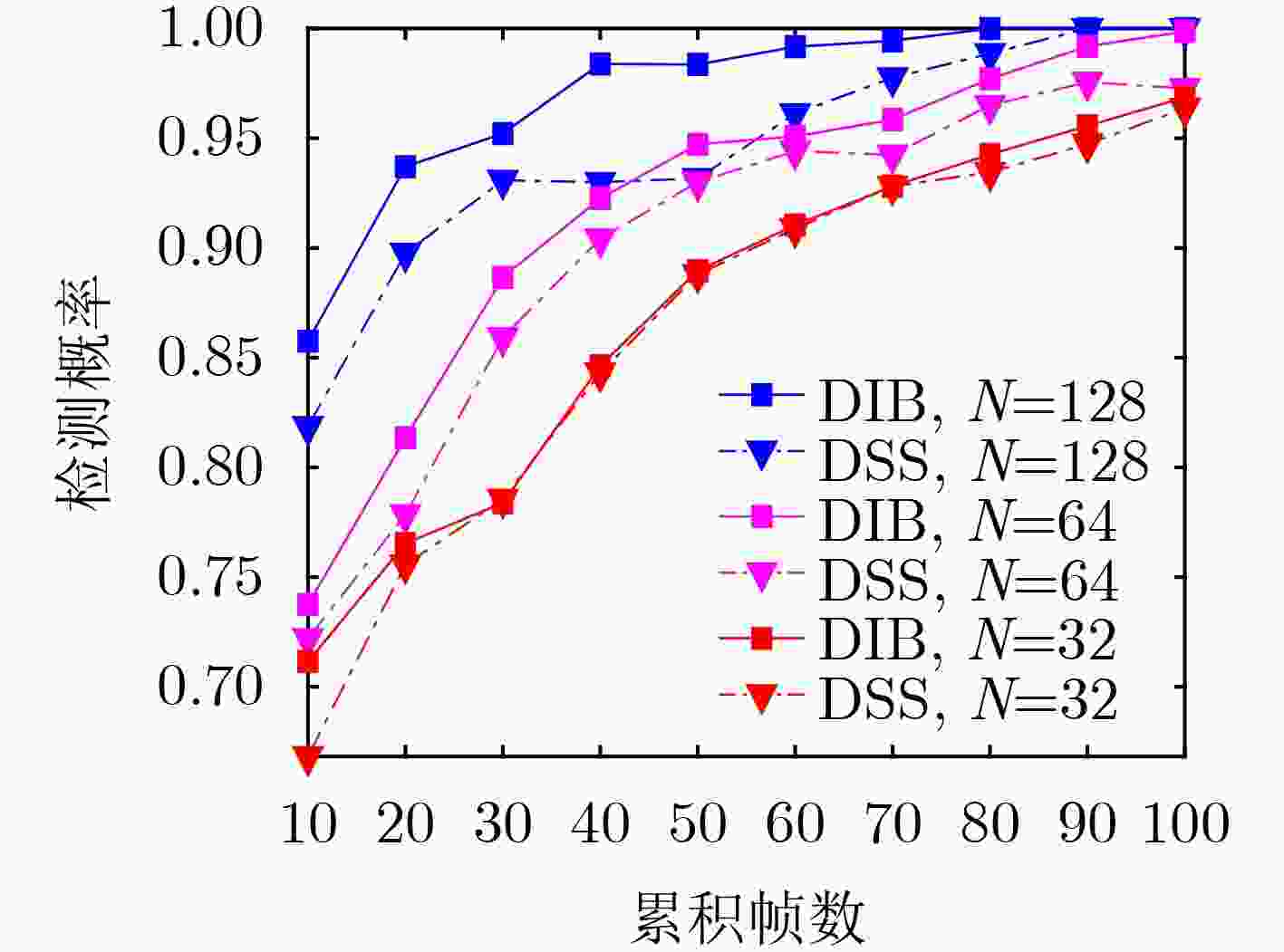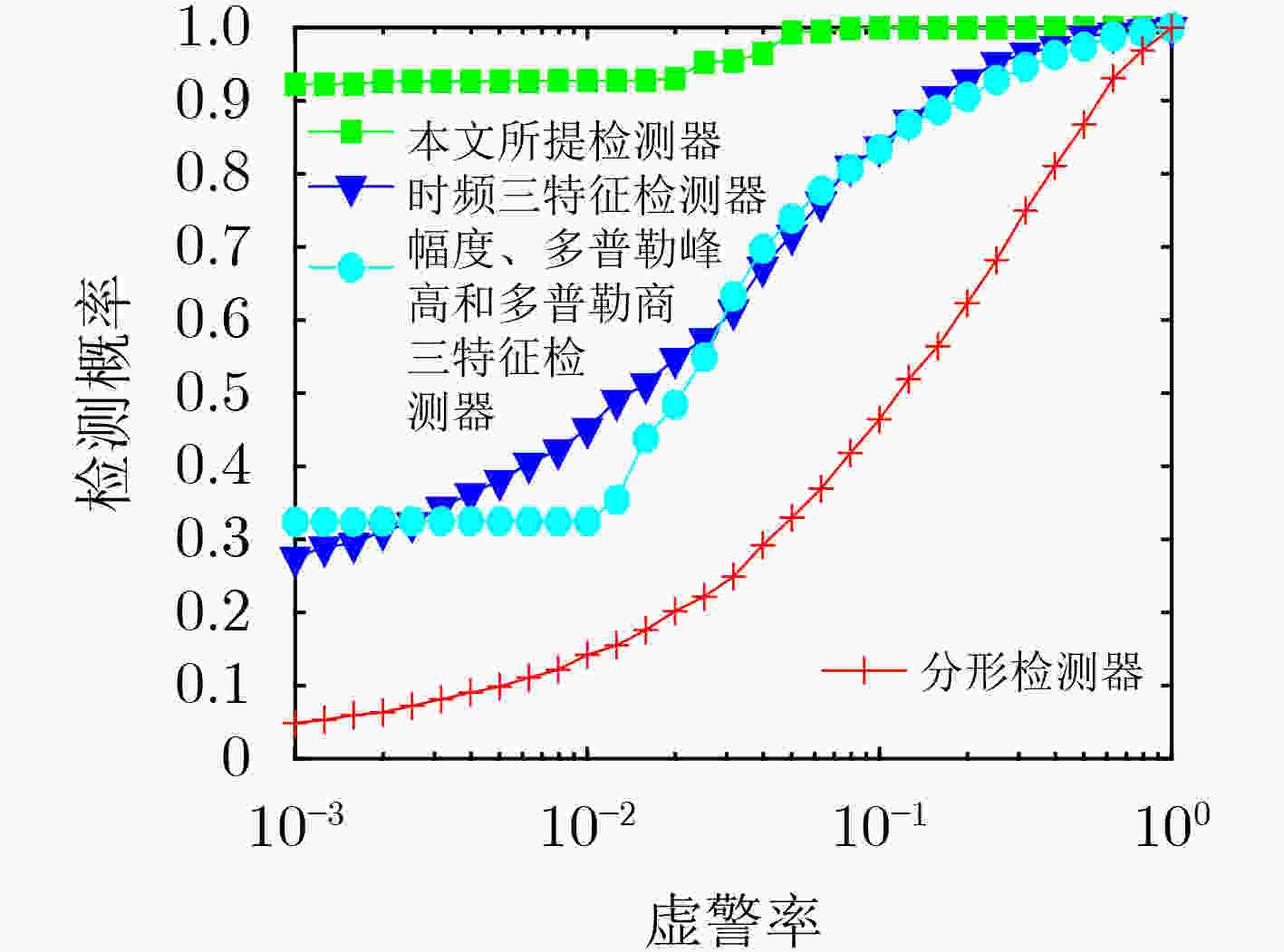A Method for Detecting Small Slow Targets in Sea Surface Based on Diagonal Integrated Bispectrum
-
摘要: 针对海杂波背景下雷达对海面慢速小目标探测技术难题,该文提出一种基于对角积分双谱的三特征融合检测方法。该方法首先从待检测信号的估计双谱中获得对角积分双谱,而后根据海杂波单元与目标单元之间的非线性耦合差异性,进一步从对角积分双谱中提取峰值、质心频率、谱宽3种特征。考虑到扫描模式下雷达采用的相干脉冲数通常较少,易导致特征不稳定,进而影响海杂波与目标可分性,为此,通过多帧扫描历史数据和当前帧数据的综合应用,对谱特征进行积累得到累积峰值、全变差、累积谱宽3种累积特征。最后采用凸包分类算法,在三特征空间进行融合检测。经实测CSIR数据集验证,在同等参数条件下,该文检测方法相比已有基于时频三特征的检测方法,基于幅度、多普勒三特征检测方法和分形特征检测方法具有更好的检测性能。Abstract: Considering the technical difficulty of radar to detect small targets embedded in the sea clutter, a three-feature fusion detection method based on diagonal integrated bispectrum is proposed. Firstly, the diagonal integrated bispectrum is obtained from the estimated bispectrum of the signal to be detected. Then, according to the nonlinear coupling difference between sea clutter cell and target cell, three features consist of peak value, centroid frequency and spectrum width are extracted from the diagonal integrated bispectrum. Considering that the number of coherent pulses used by radar in scanning mode is usually small, it is easy to lead to feature instability, and then affect the separability of sea clutter and target. For this reason, through the comprehensive application of multi-frame scanning historical data and current frame data, three cumulative features including cumulative peak value, total variation, cumulative spectrum width are obtained by accumulating three spectrum features. Finally, the convex hull classification algorithm is used to perform fusion detection in three dimensional feature space. The measured CSIR dataset verifies that, under same parameters, the proposed detection method has better detection performance compared with the existing detection methods based on three time-frequency features, amplitude feature and doppler features, fractal feature.
-
Key words:
- Target detection /
- Sea clutter /
- Diagonal integrated bispectrum /
- Three features
-
表 1 CSIR数据库中17个数据集的环境参数
编号 数据集名称 截取时间(s) 平均风速(m/s) 有效波高(m) 夹角(°) 目标单元 信杂比(dB) 1 TFA17_001 4.45 5.40 2.26 253.70 27 10.10 2 TFA17_004 13.25 5.41 2.26 253.68 27~29 3.72 3 TFA17_005 12.17 5.42 2.26 253.68 31 12.44 4 TFA17_006 13.47 5.42 2.26 253.68 29, 30 7.57 5 TFA17_007 13.47 5.44 2.26 253.69 24 11.57 6 TFA17_008 13.47 5.44 2.26 253.70 23, 24 7.88 7 TFA17_009 4.00 5.45 2.26 253.71 23 7.25 8 TFA17_010 26.73 5.47 2.27 253.73 23, 24 9.14 9 TFA17_011 4.60 5.50 2.28 253.77 25 10.49 10 TFA17_012 39.68 6.12 2.30 254.50 14~17 9.82 11 TFA17_013 39.68 6.13 2.30 254.48 18~20 7.78 12 TFA17_014 26.73 6.26 2.35 254.12 18~20 2.61 13 TFC17_001 13.47 5.34 2.27 253.68 27, 28 9.90 14 TFC17_002 13.47 5.36 2.26 253.67 26~28 4.11 15 TFC17_004 20.00 6.10 2.28 254.55 11 13.93 16 TFC17_005 15.14 6.11 2.28 254.53 12, 13 11.84 17 TFC17_006 26.73 6.28 2.35 254.05 24~26 5.07 表 2 特征来源不同时本文检测器的检测概率(%)
L DIB, N=128 DSS, N=128 DIB, N=64 DSS, N=64 DIB, N=32 DSS, N=32 10 85.75 81.87 73.75 72.20 71.15 66.83 20 93.70 89.76 81.35 77.85 76.53 75.56 30 95.21 93.09 88.66 85.92 78.39 78.55 40 98.38 92.99 92.26 90.42 84.63 84.30 50 98.36 93.17 94.72 93.00 88.96 88.80 60 99.17 96.12 95.08 94.41 91.04 90.88 70 99.44 97.75 95.85 94.24 92.81 92.81 80 100.00 98.86 97.71 96.50 94.26 93.44 90 100.00 100.00 99.19 97.56 95.56 94.74 100 100.00 100.00 99.86 97.27 96.86 96.37 表 3 4类检测器的检测概率(N=64)(%)
本文所提检测器 时频三特征检测器 幅度、多普勒峰高和多普勒商三特征检测器 分形检测器 虚警率0.001 92.26 27.53 32.39 4.87 虚警率0.01 92.78 45.13 32.46 14.21 虚警率0.1 100.00 83.67 83.35 46.41 表 4 相干脉冲数N降低时检测器的性能变化(%)
编号 本文所提检测器 时频三特征检测器 幅度、多普勒峰高和多普勒商三特征检测器 分形检测器 N=128 N=64 降低量 N=128 N=64 降低量 N=128 N=64 降低量 N=128 N=64 降低量 1 97.01 89.61 7.40 63.58 1.44 62.14 34.10 29.39 4.71 0.00 0.29 –0.29 2 52.72 49.30 3.42 27.66 7.64 20.02 8.90 4.35 4.55 0.00 0.00 0.00 3 67.43 56.58 10.85 30.32 15.47 14.84 25.26 19.58 5.68 2.74 3.26 –0.53 4 50.62 37.28 13.34 21.90 5.99 15.92 9.14 7.51 1.63 0.00 0.29 –0.29 5 72.13 82.05 –9.92 18.06 10.27 7.79 17.87 13.31 4.56 5.51 1.62 3.90 6 38.11 38.46 –0.35 12.36 6.75 5.61 19.96 6.46 13.50 0.00 0.38 –0.38 7 50.85 40.15 10.70 27.56 18.27 9.29 19.87 12.82 7.05 0.64 0.00 0.64 8 41.75 49.17 –7.42 17.93 7.85 10.07 24.26 16.19 8.07 3.07 0.86 2.21 9 47.14 71.25 –24.11 37.99 20.61 17.38 27.37 20.61 6.76 2.79 1.11 1.68 10 88.62 89.93 –1.31 46.96 14.97 32.00 51.10 31.16 19.94 5.36 5.52 –0.15 11 72.49 70.80 1.68 30.73 12.74 17.99 19.24 11.48 7.75 0.90 0.55 0.36 12 49.10 40.82 8.28 21.26 4.84 16.42 2.78 2.64 0.14 0.38 0.91 –0.53 13 68.72 64.89 3.83 12.74 5.32 7.41 23.76 15.78 7.98 5.13 2.19 2.95 14 50.62 39.25 11.37 27.00 15.49 11.50 12.55 7.70 4.85 3.80 0.86 2.95 15 98.38 92.26 6.13 61.72 27.53 34.19 36.88 32.39 4.48 8.19 4.87 3.33 16 98.55 88.99 9.56 60.41 33.25 27.16 56.18 44.42 11.76 8.29 3.47 4.82 17 66.14 56.29 9.84 26.15 9.58 16.57 17.05 12.70 4.35 3.16 2.40 0.77 -
[1] 关键. 雷达海上目标特性综述[J]. 雷达学报, 2020, 9(4): 674–683. doi: 10.12000/JR20114GUAN Jian. Summary of marine radar target characteristics[J]. Journal of Radars, 2020, 9(4): 674–683. doi: 10.12000/JR20114 [2] 王雪松, 杨勇. 海杂波与目标极化特性研究进展[J]. 电波科学学报, 2019, 34(6): 665–675. doi: 10.13443/j.cjors.2019103101WANG Xuesong and YANG Yong. Overview on cognition of clutter and target polarization characteristics for maritime radar[J]. Chinese Journal of Radio Science, 2019, 34(6): 665–675. doi: 10.13443/j.cjors.2019103101 [3] 何友, 黄勇, 关键, 等. 海杂波中的雷达目标检测技术综述[J]. 现代雷达, 2014, 36(12): 1–9. doi: 10.3969/j.issn.1004-7859.2014.12.001HE You, HUANG Yong, GUAN Jian, et al. An overview on radar target detection in sea clutter[J]. Modern Radar, 2014, 36(12): 1–9. doi: 10.3969/j.issn.1004-7859.2014.12.001 [4] 张坤, 水鹏朗, 王光辉. 相参雷达K分布海杂波背景下非相干积累恒虚警检测方法[J]. 电子与信息学报, 2020, 42(7): 1627–1635. doi: 10.11999/JEIT190441ZHANG Kun, SHUI Penglang, and WANG Guanghui. Non-coherent integration constant false alarm rate detectors against K-distributed sea clutter for coherent radar systems[J]. Journal of Electronics &Information Technology, 2020, 42(7): 1627–1635. doi: 10.11999/JEIT190441 [5] 许述文, 薛健, 水鹏朗. 基于知识的海杂波背景下距离扩展目标检测[J]. 电子与信息学报, 2016, 38(12): 3004–3010. doi: 10.11999/JEIT160905XU Shuwen, XUE Jian, and SHUI Penglang. Adaptive detection of range-spread targets based on knowledge in sea clutter background[J]. Journal of Electronics &Information Technology, 2016, 38(12): 3004–3010. doi: 10.11999/JEIT160905 [6] 徐涛, 吴军, 夏海宝, 等. 基于频域CFAR方法的PD雷达回波信号处理[J]. 现代防御技术, 2012, 40(1): 140–143. doi: 10.3969/j.issn.1009-086x.2012.01.030XU Tao, WU Jun, XIA Haibao, et al. PD radar echo processing based on the method of CFAR in frequency domain[J]. Modern Defence Technology, 2012, 40(1): 140–143. doi: 10.3969/j.issn.1009-086x.2012.01.030 [7] 许述文, 白晓惠, 郭子薰, 等. 海杂波背景下雷达目标特征检测方法的现状与展望[J]. 雷达学报, 2020, 9(4): 684–714. doi: 10.12000/JR20084XU Shuwen, BAI Xiaohui, GUO Zixun, et al. Status and prospects of feature-based detection methods for floating targets on the sea surface[J]. Journal of Radars, 2020, 9(4): 684–714. doi: 10.12000/JR20084 [8] HU Jing, TUNG W W, and GAO Jianbo. Detection of low observable targets within sea clutter by structure function based multifractal analysis[J]. IEEE Transactions on Antennas and Propagation, 2006, 54(1): 136–143. doi: 10.1109/TAP.2005.861541 [9] LUO Feng, ZHANG Danting, and ZHANG Bo. The fractal properties of sea clutter and their applications in maritime target detection[J]. IEEE Geoscience and Remote Sensing Letters, 2013, 10(6): 1295–1299. doi: 10.1109/LGRS.2013.2237750 [10] FAN Yifei, TAO Mingliang, SU Jia, et al. Weak target detection based on joint fractal characteristics of autoregressive spectrum in sea clutter background[J]. IEEE Geoscience and Remote Sensing Letters, 2019, 16(12): 1824–1828. doi: 10.1109/LGRS.2019.2912329 [11] SHUI Penglang, LI Dongchen, and XU Shuwen. Tri-feature-based detection of floating small targets in sea clutter[J]. IEEE Transactions on Aerospace and Electronic Systems, 2014, 50(2): 1416–1430. doi: 10.1109/TAES.2014.120657 [12] SHI Sainan and SHUI Penglang. Sea-surface floating small target detection by one-class classifier in time-frequency feature space[J]. IEEE Transactions on Geoscience and Remote Sensing, 2018, 56(11): 6395–6411. doi: 10.1109/TGRS.2018.2838260 [13] 郭子薰, 水鹏朗, 白晓惠, 等. 海杂波中基于可控虚警K近邻的海面小目标检测[J]. 雷达学报, 2020, 9(4): 654–663. doi: 10.12000/JR20055GUO Zixun, SHUI Penglang, BAI Xiaohui, et al. Sea-surface small target detection based on K-NN with controlled false alarm rate in sea clutter[J]. Journal of Radars, 2020, 9(4): 654–663. doi: 10.12000/JR20055 [14] GUO Zixun and SHUI Penglang. Anomaly based sea-surface small target detection using K-nearest neighbor classification[J]. IEEE Transactions on Aerospace and Electronic Systems, 2020, 56(6): 4947–4964. doi: 10.1109/TAES.2020.3011868 [15] SHUI Penglang, GUO Zixun, and SHI Sainan. Feature-compression-based detection of sea-surface small targets[J] IEEE Access, 2019, 8: 8371–8385. doi: 10.1109/ACCESS.2019.2962793. [16] SHUI Penglang, GUO Zixun. Sea-surface floating small target detection based on feature compression[J]. The Journal of Engineering, 2019, 2019(21): 8160–8164. doi: 10.1049/joe.2019.0694 [17] 陈小龙, 关键, 于晓涵, 等. 基于短时稀疏时频分布的雷达目标微动特征提取及检测方法[J]. 电子与信息学报, 2017, 39(5): 1017–1023. doi: 10.11999/JEIT161040CHEN Xiaolong, GUAN Jian, YU Xiaohan, et al. Radar Micro-Doppler signature extraction and detection via short-time sparse time-frequency distribution[J]. Journal of Electronics &Information Technology, 2017, 39(5): 1017–1023. doi: 10.11999/JEIT161040 [18] 李东宸, 水鹏朗, 许述文. 块白化杂波抑制的海面漂浮小目标检测方法[J]. 西安电子科技大学学报:自然科学版, 2016, 43(6): 21–26. doi: 10.3969/j.issn.1001-2400.2016.06.004LI Dongchen, SHUI Penglang, and XU Shuwen. Floating small target detection in the sea clutter via block-whitened clutter suppression[J]. Journal of Xidian University, 2016, 43(6): 21–26. doi: 10.3969/j.issn.1001-2400.2016.06.004 [19] XU Shuwen, ZHENG Jibin, PU Jia, et al. Sea-surface floating small target detection based on polarization features[J]. IEEE Geoscience and Remote Sensing Letters, 2018, 15(10): 1505–1509. doi: 10.1109/LGRS.2018.2852560 [20] CHEN Xiaolong, GUAN Jian, HUANG Yong, et al. Radon-linear canonical ambiguity function-based detection and estimation method for marine target with micromotion[J]. IEEE Transactions on Geoscience and Remote Sensing, 2015, 53(4): 2225–2240. doi: 10.1109/TGRS.2014.2358456 [21] 陈世超, 罗丰, 胡冲, 等. 基于多普勒谱非广延熵的海面目标检测方法[J]. 雷达学报, 2019, 8(3): 344–354. doi: 10.12000/JR19012CHEN Shichao, LUO Feng, HU Chong, et al. Small target detection in sea clutter background based on tsallis entropy of Doppler spectrum[J]. Journal of Radars, 2019, 8(3): 344–354. doi: 10.12000/JR19012 [22] 李军伟. 双谱分析新方法及其工程应用研究[D]. [硕士论文], 郑州大学, 2006.LI Junwei. A new method of bispectral analysis and its engineering application[D]. [Master dissertation], Zhengzhou University, 2006. [23] TANG Li and JIANG Ting. Target identification based on diagonal slice of the complex bispectrum[C]. Proceedings of 2014 IEEE International Conference on Communiction Problem-solving, Beijing, China, 2014: 303–306. doi: 10.1109/ICCPS.2014.7062279. [24] ZHANG Xianda, SHI Yu, and BAO Zheng. A new feature vector using selected bispectra for signal classification with application in radar target recognition[J]. IEEE Transactions on Signal Processing, 2001, 49(9): 1875–1885. doi: 10.1109/78.942617 [25] HERSELMAN P L, BAKER C J, and DE WIND H J. An analysis of X-band calibrated sea clutter and small boat reflectivity at medium-to-low grazing angles[J]. International Journal of Navigation and Observation, 2008, 2008: 347518. doi: 10.1155/2008/347518 [26] HERSELMAN P L and BAKER C J. Analysis of calibrated sea clutter and boat reflectivity data at C- and X-band in south African coastal waters[C]. Proceedings of 2007 IET International Conference on Radar Systems, Edinburgh, UK, 2007. doi: 10.1049/cp:20070616. [27] 丁昊, 刘宁波, 董云龙, 等. 雷达海杂波测量试验回顾与展望[J]. 雷达学报, 2019, 8(3): 281–302. doi: 10.12000/JR19006DING Hao, LIU Ningbo, DONG Yunlong, et al. Overview and prospects of radar sea clutter measurement experiments[J]. Journal of Radars, 2019, 8(3): 281–302. doi: 10.12000/JR19006 -






 下载:
下载:














 下载:
下载:
